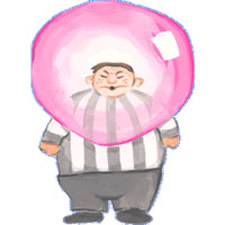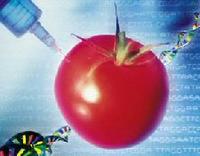Reason to love Curves
Tuesday, November 13, 2007
Tuesday, September 25, 2007
Why do Onions make us cry ???

Onions are rich in nutrients including vitamins B and C, protein, calcium and iron.
It is not the strong odour of the onion that makes us cry, but the substances that the onion releases when we chop it. The vegetable contains some sulphur compounds which are released when chopped. Sulphur being an irritant to both our nose and eyes, makes tears flow out.
What actually happens:
When the sulphur compound comes in contact with the water in our eyes, it produces very dilute sulphuric acid. This acid then irritates the eyes. In response to this acid, our eyes automatically blink and produce tears, which wash the eye and flush out the acid.
NO STINK FABRIC
 Researchers at the Indian Institute of Technology, Delhi, have enlisted a natural ally to fight the foul smell that emanates from clothes after they have been worn. The fabric is first given an anti-microbial treatment to keep odour-causing germs at bay, which may fail to go even after washing. The material used for such treatment is normally of synthetic origin. Researchers have isolated a compound from neem seeds, which when blended with glycol, could foster anti-microbial properties lasting upto 25 washes.
Researchers at the Indian Institute of Technology, Delhi, have enlisted a natural ally to fight the foul smell that emanates from clothes after they have been worn. The fabric is first given an anti-microbial treatment to keep odour-causing germs at bay, which may fail to go even after washing. The material used for such treatment is normally of synthetic origin. Researchers have isolated a compound from neem seeds, which when blended with glycol, could foster anti-microbial properties lasting upto 25 washes.Saturday, September 08, 2007
Rasogolla: Food for your eyes!

Researchers at Calcutta’s Jadavapur University have succeeded in fortifying the rasogolla, the favourite dessert of Bengalis, with beta-carotene, a precursor to vitamin A.
Scientists from the department of food technology and biochemical engineering mixed carrot paste with cottage cheese which went into making the ping pong-like juicy balls. Among the various concentrations tried out, the one with 30 per cent carrot paste was found to possess the highest levels of beta-carotene.
Carrot rasogollas were found to be quite similar to the traditional ones in terms of moisture, sugar content, elasticity and cohesiveness, but had different fat and protein levels. The fortified sweet could be useful in fighting acute vitamin A deficiency, a major cause of childhood blindness and severe visual impairment in India.
Sunday, February 25, 2007
Vitamins make teens active

Teenagers who take a daily multivitamin supplement have a healthier diet and lifestyle than those who don’t take vitamins. A team led by a University of Minnesota researcher found that adolescents who took vitamins:
- had a lower rate of smoking, 29 vs 33 per cent;
- were less likely to be overweight, 31 vs 37 per cent.
Nobel Prize boosts life span
Friday, February 23, 2007
Why does your stomach growl when you are hungry?

Doctors call it “borborygmi”. Sounds somewhat like the sound you hear, isn’t it?
Growling in the stomach is a common phenomenon all of us would have experienced sometime or the other. “The stomach muscles are in constant peristaltic motion to digest the food ingested and letting it flow into the intestines. In general, increased flow within the system causes the stomach to growl”.
In the absence of food the stomach walls squeeze together in an attempt to mix and digest food, the gases and digestive juices slosh around in the empty organ creating the noise
Monday, January 08, 2007
MOLECULAR CONDOM
 University of Utah scientists have designed a “molecular condom” that women could use daily to prevent AIDS by vaginally inserting a liquid that would turn into a gel-like coating and then, when exposed to semen, return to liquid form and release an antiviral drug.
University of Utah scientists have designed a “molecular condom” that women could use daily to prevent AIDS by vaginally inserting a liquid that would turn into a gel-like coating and then, when exposed to semen, return to liquid form and release an antiviral drug. The molecular condom is part of a worldwide research effort to develop “microbicides” — drug-delivery systems such as gels, sponges or creams to prevent infection by HIV and other sexually transmitted diseases, according to an online report published in the Journal of Pharmaceutical Sciences. Microbicides will give women greater power to protect themselves from HIV, particularly in impoverished nations where AIDS is widespread or where conventional condoms are taboo.
Sunday, December 10, 2006
Meat Preservatives HEALTHY


A University of Illinois food scientist and her team has discovered that certain solutions used by meat processors to extend shelf life actually do double duty as anti-microbial agents, killing such virulent foodborne pathogens as E. coli 0157:H7. That’s important because E. coli can be spread via recycled solutions used to tenderise and enhance flavour in steaks, chops, and other cuts of meat.
The researchers add, “Consumers should realise that the cook is the last point of control for eliminating toxic organisms. If meat is cooked until it’s well done, you won’t have a problem.”
Friday, December 01, 2006
CHOCOLATE

Fulfilling the dreams of chocaholics everywhere, US researchers have shown that a few squares of chocolate a day can almost halve the risk of heart attack death by decreasing the tendency of platelets to clot in narrow blood vessels. This is due to chemicals called flavonoids found in dark chocolates. The finding was presented at the American Heart Association’s annual scientific session in November.
Tuesday, November 21, 2006

In a new survey of noise levels of the New York City transit system, researchers at Columbia University found that exposure to noise levels in subways have the potential to exceed recommended guidelines of the World Health Organization (WHO). According to the research reported in the Journal of Urban Health, as little as 30 minutes of exposure to decibel levels measured in the New York City transit system per day has the potential to result in hearing loss. Noise exposure and noise-induced hearing loss is a global health problem of significant magnitude, especially in urban settings.
Tuesday, September 19, 2006
CHEW in STYLE

A chewing gum containing good bacteria that can destroy the bad bacteria causing tooth decay could be in the shops soon.
A new strain of lactobacillus called L. anti-caries, which binds to Strepptococcus mutans, the bacteria responsible for tooth decay.
S. mutans sticks to the surface of teeth, where it produces an aggressive acid that breaks down the enamel. The friendly bugs will make the S. mutans clump together, preventing them from becoming attached to the tooth surface.
Tests reveal that the chewing gum can reduce the amount of bacteria in the mouth 50 times!
Monday, July 24, 2006
Why do Smoking blacken Lips ???

On smoking nicotine enters into the blood & acts as chemical stimulator to accelerate the process of melanin deposition in skin.This increased quantity of melanin imparts a greyish black hue to the skin.Skin, teeth, gums, nails, lungs get stained too but facial region being more sensitive, the effect is prominent.
THE DAMAGE RENDERED TO THE SKIN DOESN'T REVERT EVEN AFTER QUITTING SMOKING !!!
Wednesday, July 19, 2006
Tomato Vaccine

Genetically modified tomatoes will soon be used to combat HIV and hepatitis B virus (HBV).
The primary objective is to make affordable vaccines that can be easily processed in the countries most affected by the killer viruses.
Researchers at the Siberian Institute of Plant Physiology and Biochemistry in Russia used a soil bacterium to ‘shuttle’ a synthetic combination of HIV and HBV DNA fragments into tomato plants, which in turn manufacture proteins.
When they are eaten, these proteins help the body create antibodies against the viruses.
Tuesday, May 16, 2006

Why does a bump cause a goose egg on the head?
The familiar goose egg forms because of the extremely rich supply of small blood vessels in and under the scalp. When they rupture with even a slight bump and the skin is intact, the blood has no place to go, and the pooled blood pushes outward, sometimes to an alarming degree and forms GOOSE EGG !!!

An engineered virus can track down and infect the most common and deadly form of brain cancer, and then kill tumour cells by forcing them to devour themselves, according to researchers at the University of Texas. This virus uses telomerase, an enzyme found in 80 per cent of brain tumours, as a target. Once the virus enters the cell, it needs telomerase to replicate. Normal brain tissue does not have telomerase, so this virus replicates only in cancer cells.
Biogas train

Svensk Biogas of Sweden has unveiled the world’s first biogas-powered passenger train. Fitted with two biogas bus engines, this can carry up to 54 passengers with a velocity of 130 km/h. Biogas, produced by decomposing organic material, emits far less carbon dioxide than traditional fossil fuels. The environment-friendly $1,300,000 train can run for 600 km before it needs to refuel. It may eventually replace diesel or electric trains.
Sunday, March 19, 2006

Don Quixote And Sancho
Brain power
Here’s Don Quixote and Sancho drawing attention once again. Just that this time they are together as a two-headed baby turtle, the left head is called Don Quixote and the right, Sancho. The turtle is proving to be huge draw at an aquarium in Chile. According to its owner, vet Federico Errazuriz, the turtle is normal, apart from the two heads with two brains, and will live up to 15 years.
 Fungus fights malaria
Fungus fights malariaMould in your house may keep malaria at bay by killing off the mosquitoes which carry the contagion. Researchers at the Imperial College in London found that an oil-based live spore (found in mould) spray could be a viable alternative to the insecticides to which mosquitoes have grown resistant. The fungi have already been successfully used to keep agricultural pests at bay. The oil-based spray of the Beauveria bassiana fungus either kills or maims the mosquitoes so that they can’t spread malaria.
A field study in Tanzania showed that the fungal spray slashed the lifespan of the pests and significantly cut down malaria in the endemic zone. The biggest advantage of the fungal insecticide is its low cost.
Saturday, March 11, 2006
GLOWING PLANTS

Some people like to talk to their plants. Now, students at Singapore Polytechnic say they have created a plant that can commmunicate with people — by glowing when it needs water.
The students said today that they have genetically modified a plant using a green fluorescent marker gene from jellyfish, so that it “lights up” when it is stressed as a result of dehydration.
The light is hard to detect with the naked eye but can be seen using an optical sensor developed in collaboration with students at Singapore’s Nanyang Technological University.
Thursday, February 23, 2006
Kissing leads to meningitis

Intimate kissing with multiple partners, attending college, and a history of preceding illness are independent risk factors for meningococcal disease in adolescents, a new research shows. However, religious observance and meningococcal vaccination are tied to reduced risks, according to a report in the British Medical Journal. Meningococcal disease — a bacterial infection of the fluid within the tissues surrounding the brain and spinal cord — is largely a disease affecting children younger than five years, although in recent years both the US and UK have seen rising rates among teens, say researchers at the University of London.
Friday, February 17, 2006

Cancer Bite
A fatal cancer afflicting Tasmanian devils passes from one of the small marsupials to another when they bite each other, rather than being transmitted via a virus, according to a team of Australian researchers. The study, reported in the journal Nature, is the first documented instance of trauma-transmitted cancer.
A fatal cancer afflicting Tasmanian devils passes from one of the small marsupials to another when they bite each other, rather than being transmitted via a virus, according to a team of Australian researchers. The study, reported in the journal Nature, is the first documented instance of trauma-transmitted cancer.
Saturday, January 21, 2006
Subscribe to:
Posts (Atom)






